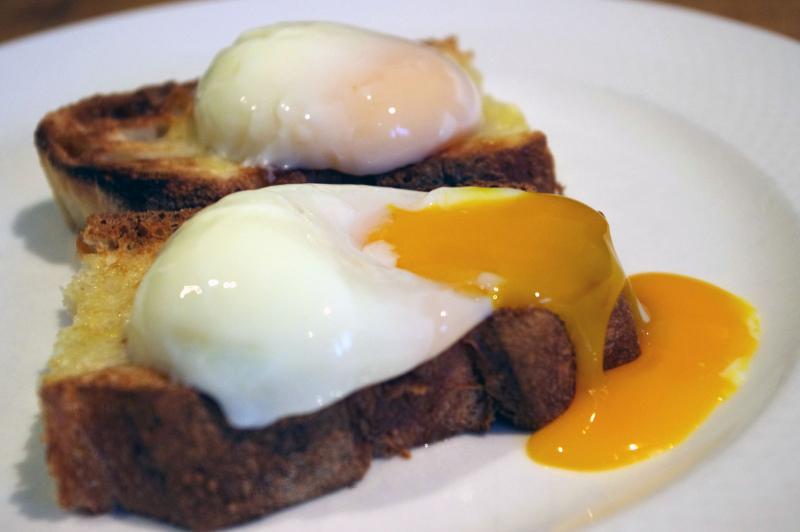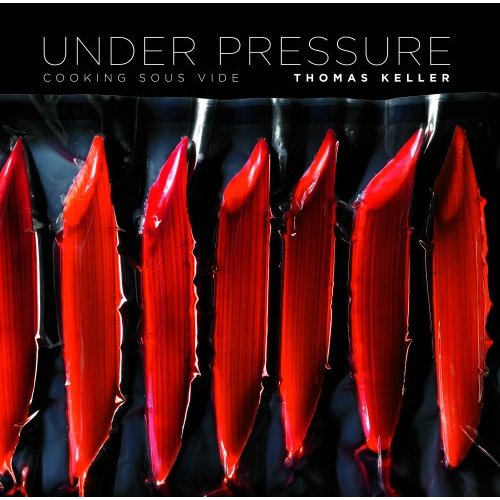Every project I get I try to spin it so it can involve food somehow, so for my chemistry project I wrote about sous vide cookery! Read on!
Sous vide is a method of cooking where food is placed in a vacuum sealed bag and cooked at very low temperatures for a very long time (usually). This new cooking technique was developed by Georges Pralus in 1974. The equipment involved in cooking sous vide includes an immersion circulator and a cryovac. The immersion circulator is placed in a water bath and controls the temperature of the water to .01 degrees of what you set it at. A cryovac takes all of the air out of the bag by using a vacuum. This produces food that is cooked uniformly throughout. When you traditionally cook a steak you would sear it over a very high temperature and the resulting product will be overcooked on the exterior and under cooked in the interior. When a steak is cooked sous vide the whole piece of meat from top to bottom is cooked to a perfect medium rare (55 degrees C). Food cooked sous vide is more flavorful and as well more nutritious. When you blanch broccoli for instance lots of the nutrients leach out of the broccoli (diffusion and osmosis) to try and form equilibrium. When broccoli is cooked sous vide nothing leaches out of the broccoli because the bag that it is placed in is vacuum sealed. Furthermore, cooking sous vide prohibits the growth of aerobic pathogens because there is zero air in the bag when it is sealed properly. Sous vide is the most efficient way to transfer thermal energy from water to your food. Sous Vide cookery is used in 99.999% of all of the great restaurants. The only place where to my knowledge it is not used is at Le Bernadin, where Chef Eric Ripert does not like the effect it has on seafood. Cooking sous vide eases service at restaurants because fewer things need to be prepared or heated a la minute. Braised meats can be held sous vide at temperatures lower or equal to the desired doneness because the product will not overcook in the period of a service, but if held too long the proteins will start to turn into mush. Some products are cooked for days sous vide (short ribs are cooked for 3 days). Typically traditional short ribs are overcooked, but the collagen turns to gelatin and remoistens the meat. Cooked sous vide short ribs can be served medium rare and the collagen is also denatured into gelatin.
First off all of cooking is a science. Chemical reactions are constantly taking place, whether a cake is being baked or pork is being brined. In regards to sous vide cookery lots of scientific reactions occur as well. A cryovac works by creating a low pressure environment in and around the bag, which allows the gas to escape and the liquid to contain. When pressure is decreased at constant temperature volume expands. This expansion in volume lets the gas molecules expand out of the bag, so all of the air becomes removed. A phase change that takes place is the vaporization of alcohol. If alcohol is not evaporated before added to your bag it will go through a phase change from a liquid to a gas in the bag, which is extremely detrimental. This will both alter the temperature of the bag – cooking the meat unevenly and can lead to the spread of anaerobic pathogens. Another cool technique that can be done with a cryovac is “quick pickling”, where a brine is added to a vegetable and the vacuumed. When this happens osmosis and diffusion happen at a much higher rate. The vegetables cell walls break down and swell up with the brine. If you bag an ingredient in a cryovac its shelf life is increased by 3-5 times because oxidation cannot take place because the food is an anaerobic environment. In traditional cooking raw mierpoix (onion, celery, carrot) is added to food while cooking to add flavor, but in sous vide it does not work because the temperatures do not get high enough for the vegetables to denature and give off flavor. When eggs are cooked with an immersion circulator (not considered sous vide because the eggs are not placed in a vacuum bag) they go through a phase change from liquid to a “solid” (However they should not be cooked all the way to a solid state, then they will be over cooked. The perfect egg is cooked to 63.3 degrees
A common criticism of sous vide cookery is that there is no roasted or savory flavors. This is true if you do not sear your meat before and after it enters the bag. Searing meat inhibits the maillard reaction to take place, which involves the combination of amino acids and sugars at very high heats. The reaction itself has over 100 products, so there is no way it would fit on this brochure.
As stated before in this brochure, sous vide cookery has numerous perks (I don’t see a point listing all of them again, so I will only list a few). Cooking sous vide makes cooking much more precise and as well accurate. If you place a duck breast in a vacuum bag and cook it with an immersion circulator at 130 degrees Fahrenheit it will never cook past 130 degrees. This helps restaurants be more consistent, which is a must for a great restaurant. The storage of meats is greatly enhanced by the use of a cryovac, and makes for less space. I can go on and on…..
The one major hazard of sous vide cookery is the growth of anaerobic pathogens, mainly botulism. If food is not cooked long enough or not heated to a specific temperature it can make you very ill. The temperatures and time depend on the product and the size of the product you are using. The price of the equipment is also very expensive, both the immersion circulator and cryovac combined can set you back over $3,000.
Do benefits outweigh hazards? In short yes!!
The benefits of cooking sous vide are endless and are changing restaurant cooking for the better. I think in about 30 years housewives will be cooking a version of sous vide for the ease in using and the constant great results. The sous vide supreme debuted this year which is the first time cooking sous vide was marketed for the home cook. It is not as precise, but very close and still costs a hefty $400. Mind you if cooking sous vide becomes too popular it will end cooking itself. The huge corporate company that decides to completely adapt cooking sous vide to the home cook will destroy it. When they start selling food already vacuum bagged in the super market and instruct you to throw it in your water bath that will be a sad day. Cooking sous vide removes some emotion of cooking, you don’t get to smell your food while it is cooking, or listen to the bubbling braising liquid. You just “throw” it into a bag. Cooking techniques like searing, braising, roasting, poaching, etc. must always still be in practice. If cooking sous vide wipes other cooking techniques from existence it will destroy food.
(Pictures I did NOT Take)







I like all your products, the Sous Vide Professional is designed and manufactured. With the Sous Vide Professional, we have achieved these goals. We understand, though that some of our customers may not be ready to move onto, our newest product and that’s why we’re still offering both models, for now.
ReplyDelete